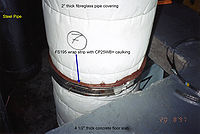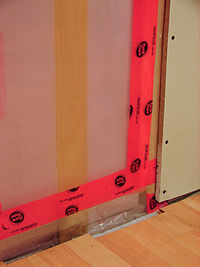- Vapor barrier
-
 Glass wool pipe insulation covering a steel pipe as it penetrates a mock-up concrete slab whose opening will be firestopped. In this manner, the vapor barrier (in this case made of foil scrim kraft paper, called ASJ, All Service Jacket, aluminium on the inside, white paper on the outside) can remain intact as it penetrates the fire barrier.
Glass wool pipe insulation covering a steel pipe as it penetrates a mock-up concrete slab whose opening will be firestopped. In this manner, the vapor barrier (in this case made of foil scrim kraft paper, called ASJ, All Service Jacket, aluminium on the inside, white paper on the outside) can remain intact as it penetrates the fire barrier.
A vapor barrier (or vapour barrier) is often used to refer to any material for damp proofing, typically a plastic or foil sheet, that resists diffusion of moisture through wall, ceiling and floor assemblies of buildings and of packaging. Technically, many of these materials are only vapor retarders as they have varying degrees of permeability.
Materials have a moisture vapor transmission rate that is established by standard test methods. One common set of units is g/m²/day. or g/100in²/day. Permeability can be reported in perms, a measure of the rate of transfer of water vapor through a material (1.0 US perm = 1.0 grain/square-foot·hour·inch of mercury ≈ 57 SI perm = 57 ng/s·m2·Pa). Vapor retarding materials are generally categorized as impermeable (≤1 US perm, or ≤57 SI perm), semi-permeable (1-10 US perm, or 57-570 SI perm), and permeable (>10 US perm, or >570 SI perm).
Contents
Materials
Materials used as vapor retarders:
- Aluminum foil, 0.05 US perm (2.9 SI perm).
- Paper-backed aluminum.
- Polyethylene plastic sheet, 4 or 6 thou (0.10 or 0.15 mm), 0.03 US perm (1.7 SI perm).
- Advanced Polyethylene vapor retarders that pass the ASTM E 1745 standard tests ≤0.3 US perm (17 SI perm).
- Asphalt-coated kraft paper, often attached to one side of fiberglass batts, 0.40 US perm (22 SI perm).
- Metallized film
- Vapor retarder paints (for the air-tight drywall system, for retrofits where finished walls and ceilings will not be replaced, or for dry basements: can break down over time due to being chemically based).
- Extruded polystyrene or foil-faced foam board insulation.
- Exterior grade plywood, 0.70 US perm (40 SI perm).
- Most sheet type monolithic roofing membranes.
- Glass and metal sheets (such as in doors and windows).
Building construction
Water vapor moves into building cavities by two mechanisms: diffusion through building materials and by air transport (leakage), which is usually far more significant and problematic. A vapor retarder and an air barrier serve to reduce this problem, but are not necessarily interchangeable.
Vapor retarders slow the rate of vapor diffusion into the thermal envelope of a structure. Other wetting mechanisms, such as wind-borne rain, capillary wicking of ground moisture, air transport (infiltration), are equally important.
Usage
In modern construction, vapor barriers have become controversial.[1] but their use is legislated within the building code of some countries (such as the U.S., Canada, Ireland, England, Scotland & Wales). Current building science recommendations are to vary the location of the vapor retarder in the thermal envelope (exterior walls and ceiling/roof) depending on the climate zone. Some building codes require an interior vapor retarder in heating-dominated climates or an exterior vapor retarder in cooling-dominated climates. In most climates, however, it is often better to have a vapor-open building assembly, meaning that walls and roofs should be designed to dry:[2] either to the inside, the outside, or both.
Basements
In areas below foundation level (or, subgrade areas), particularly those formed in concrete, vapor retarder placement can be problematic, as moisture infiltration from capillary action can exceed water vapor movement outward through framed and insulated walls.
Under concrete slabs
A slab-on-grade or basement floor should be poured over a cross-laminated polyethylene vapor barrier over 4 inches (10 cm) of granular fill to prevent wicking of moisture from the ground and radon gas incursion.
Steel buildings
Inside a steel building, water vapor will condense whenever it comes into contact with a surface that is below the dew point temperature. Visible condensation on windowpanes and purlins that results in dripping can be somewhat mitigated with ventilation; however insulation is the preferred method of condensation prevention.
Packaging
Main articles: Package testing , Moisture vapor transmission rate, Oxygen transmission rate, and Carbon dioxide transmission rateThe ability of a package to control the permeation and penetration of gasses is vital for many types of products. Tests are often conducted on the packaging materials but also on the completed packages, sometimes after being subjected to flexing, handling, vibration, or temperature.
See also
External links
- Consumer's Guide to Vapor Barriers at the U.S. Department of Energy
- Vapor Barriers Under Laminate Floors
- Green Building Advisor: Vapor Retarders and Vapor Barriers
- Building Science Fundamentals: Air Barriers vs. Vapor Barriers Green Building Advisor
- Vapor Barriers Are a Good Thing, Right? Fine Homebuilding
References
- Fine Homebuilding No. 169 March 2005 p. 78
- Fine Homebuilding No. 162, May 2004 p. 52
Categories:- Moisture protection
- Construction
- Psychrometrics
- Heating, ventilating, and air conditioning
Wikimedia Foundation. 2010.

